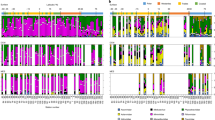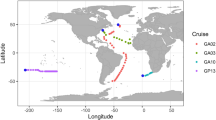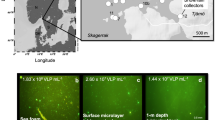Abstract
Viruses exist wherever life is found. They are a major cause of mortality, a driver of global geochemical cycles and a reservoir of the greatest genetic diversity on Earth. In the oceans, viruses probably infect all living things, from bacteria to whales. They affect the form of available nutrients and the termination of algal blooms. Viruses can move between marine and terrestrial reservoirs, raising the spectre of emerging pathogens. Our understanding of the effect of viruses on global systems and processes continues to unfold, overthrowing the idea that viruses and virus-mediated processes are sidebars to global processes.
This is a preview of subscription content, access via your institution
Access options
Subscribe to this journal
Receive 51 print issues and online access
$199.00 per year
only $3.90 per issue
Buy this article
- Purchase on Springer Link
- Instant access to full article PDF
Prices may be subject to local taxes which are calculated during checkout




Similar content being viewed by others
References
Bergh, O., Børsheim, K. Y., Bratbak, G. & Heldal, M. High abundance of viruses found in aquatic environments. Nature 340, 467–468 (1989).
Proctor, L. M. & Fuhrman, J. A. Viral mortality of marine bacteria and cyanobacteria. Nature 343, 60–62 (1990).
Suttle, C. A., Chan, A. M. & Cottrell, M. T. Infection of phytoplankton by viruses and reduction of primary productivity. Nature 347, 467–469 (1990).
Wilhelm, S. W. & Suttle, C. A. Viruses and nutrient cycles in the sea. Bioscience 49, 781–788 (1999).
Fuhrman, J. A. Marine viruses and their biogeochemical and ecological effects. Nature 399, 541–548 (1999).
Wommack, K. E. & Colwell, R. R. Virioplankton: viruses in aquatic ecosystems. Microbiol. Mol. Biol. Rev. 64, 69–114 (2000).
Weinbauer, M. G. Ecology of prokaryotic viruses. FEMS Microbiol. Rev. 28, 127–181 (2004).
Weinbauer, M. G. & Rassoulzadegan, F. Are viruses driving microbial diversification and diversity? Environ. Microbiol. 6, 1–11 (2004).
Cochlan, W. P., Wikner, J., Steward, G. F., Smith, D. C. & Azam, F. Spatial distribution of viruses, bacteria and chlorophyll a in neritic, oceanic and estuarine environments. Mar. Ecol. Prog. Ser. 92, 77–87 (1993).
Paul, J. H., Rose, J. B., Jiang, S. C., Kellogg, C. A. & Dickson, L. Distribution of viral abundance in the reef environment of Key Largo, Florida. Appl. Environ. Microbiol. 59, 718–724 (1993).
Boehme, J. et al. Viruses, bacterioplankton, and phytoplankton in the southeastern Gulf of Mexico: distribution and contribution to oceanic DNA pools. Mar. Ecol. Prog. Ser. 97, 1–10 (1993).
Maranger, R. & Bird, D. F. Viral abundances in aquatic systems: a comparison between marine and fresh waters. Mar. Ecol. Prog. Ser. 121, 217–226 (1995).
Hewson, I., O'Neil, J. M., Fuhrman, J. A. & Dennison, W. C. Virus-Like particle distribution and abundance in sediments and overlying waters along eutrophication gradients in two subtropical estuaries. Limnol. Oceanogr. 46, 1734–1746 (2001).
Middelboe, M., Glud, R. N. & Finster, K. Distribution of viruses and bacteria in relation to diagenetic activity in an estuarine sediment. Limnol. Oceanogr. 48, 1447–1456 (2003).
Bird, D. F. et al. Subsurface viruses and bacteria in Holocene/Late Pleistocene sediments of Saanich Inlet, BC: ODP holes 1033b and 1034b, Leg 169s. Mar. Geol. 174, 227–239 (2001).
Danovaro, R., Corinaldesi, C., Dell'anno, A., Fabiano, M. & Corselli, C. Viruses, prokaryotes and DNA in the sediments of a deep-hypersaline anoxic basin (DHAB) of the Mediterranean Sea. Environ. Microbiol. 7, 586–592 (2005).
Hennes, K. P. & Suttle, C. A. Direct counts of viruses in natural waters and laboratory cultures by epifluorescence microscopy. Limnol. Oceanogr. 40, 1050–1055 (1995).
Noble, R. T. & Fuhrman, J. A. Use of SYBR Green I for rapid epifluorescence counts of marine viruses and bacteria. Aquat. Microb. Ecol. 14, 113–118 (1998).
Brussaard, C. P. D. Optimization of procedures for counting viruses by flow cytometry. Appl. Environ. Microbiol. 70, 1506–1513 (2004).
Bettarel, Y., Sime-Ngando, T., Amblard, C. & Laveran, H. A comparison of methods for counting viruses in aquatic systems. Appl. Environ. Microbiol. 66, 2283–2289 (2000).
Wen, K., Ortmann, A. C. & Suttle, C. A. Accurate estimation of viral abundance by epifluorescence microscopy. Appl. Environ. Microbiol. 70, 3862–3867 (2004).
Guixa-Boixereu, N., Vaque, D., Gasol, J. M., Sanchez-Camara, J. & Pedros-Alio, C. Viral distribution and activity in Antarctic waters. Deep-Sea Res. II 49, 827–845 (2002).
Ortmann, A. C. & Suttle, C. A. High abundances of viruses in a deep-sea hydrothermal vent system indicates viral mediated microbial mortality. Deep-Sea Res. I 52, 1515–1527 (2005).
Jelmert, A. & Oppen-Berntsen, D. O. Whaling and deep-sea biodiversity. Conserv. Biol. 10, 653–654 (1996).
Wilhelm, S. W., Weinbauer, M. G., Suttle, C. A., Pledger, R. J. & Mitchell, D. L. Measurements of DNA damage and photoreactivation imply that most viruses in marine surface waters are infective. Aquat. Microb. Ecol. 14, 215–222 (1998).
Suttle, C. A. in Viral Ecology (ed. Hurst, C. J.) 248–286 (Academic, New York, 2000).
Lawrence, J. E., Chan, A. M. & Suttle, C. A. Viruses causing lysis of the toxic bloom-forming alga, Heterosigma akashiwo (Raphidophyceae), are widespread in coastal sediments of British Columbia, Canada. Limnol. Oceanogr. 47, 545–550 (2002).
Suttle, C. A. & Chan, A. M. Dynamics and distribution of cyanophages and their effect on marine Synechococcus spp. Appl. Environ. Microbiol. 60, 3167–3174 (1994).
Cottrell, M. T. & Suttle, C. A. Dynamics of a lytic virus infecting the photosynthetic marine picoflagellate, Micromonas pusilla. Limnol. Oceanogr. 40, 730–739 (1995).
Frank, H. & Moebus, K. An electron microscopic study of bacteriophages from marine waters. Helgolander Meeresunters 41, 385–414 (1987).
Moebus, K. & Nattkemper, H. Bacteriophage sensitivity patterns among bacteria isolated from marine waters. Helgolander Meeresunters 34, 375–385 (1981).
Kellogg, C. A., Rose, J. B., Jiang, S. C., Thurmond, J. & Paul, J. H. Genetic diversity of related vibriophages isolated from marine environments around Florida and Hawaii, USA. Mar. Ecol. Prog. Ser. 120, 89–98 (1995).
Wichels, A. et al. Bacteriophage diversity in the North Sea. Appl. Environ. Microbiol. 64, 4128–4133 (1998).
Sullivan, M. B., Waterbury, J. B. & Chisholm, S. W. Cyanophages infecting the oceanic cyanobacterium Prochlorococcus. Nature 424, 1047–1051 (2003).
Van Etten, J. L., Graves, M. V., Muller, D. G., Boland, W. & Delaroque, N. Phycodnaviridae — Large DNA algal viruses. Arch. Virol. 147, 1479–1516 (2002).
Lang, A. S., Culley, A. I. & Suttle, C. A. Genome sequence and characterization of a virus (HaRNAV) related to picorna-like viruses that infects the marine toxic bloom-forming alga Heterosigma akashiwo. Virology 320, 206–217 (2004).
Brussaard, C. P. D., Noordeloos, A. A. M., Sandaa, R. A., Heldal, M. & Bratbak, G. Discovery of a dsRNA virus infecting the marine photosynthetic protist Micromonas pusilla. Virology 319, 280–291 (2004).
Takao, Y., Nagasaki, K., Mise, K., Okuno, T. & Honda, D. Isolation and characterization of a novel single-stranded RNA virus infectious to a marine fungoid protist, Schizochytrium sp. (Thraustochytriaceae, Labyrinthulea). Appl. Environ. Microbiol. 71, 4516–4522 (2005).
Nagasaki, K. et al. Previously unknown virus infects marine diatom. Appl. Environ. Microbiol. 71, 3528–3535 (2005).
Lawrence, J. E., Chan, A. M. & Suttle, C. A. A novel virus (HaNIV) causes lysis of the toxic bloom-forming alga Heterosigma akashiwo (Raphidophyceae). J. Phycol. 37, 216–222 (2001).
Bettarel, Y. et al. Isolation and characterisation of a small nuclear inclusion virus infecting the diatom Chaetoceros c.f. gracilis. Aquat. Microb. Ecol. (in the press).
Garza, D. R. & Suttle, C. A. Large double-stranded DNA viruses which cause the lysis of marine heterotrophic nanoflagellates (Bodo sp.) occur in natural marine virus communities. Aquat. Microb. Ecol. 9, 203–210 (1995).
Raoult, D. et al. The 1.2-megabase genome sequence of mimivirus. Science 306, 1344–1350 (2004).
Van Hulten, M. C. W. et al. The White Spot Syndrome Virus DNA genome sequence. Virology 286, 7–22 (2001).
Zhang, S., Shi, Z., Zhang, J. & Bonami, J. R. Purification and characterization of a new reovirus from the Chinese Mitten Crab, Eriocheir sinensis. J. Fish Dis. 27, 687–692 (2004).
Chen, F., Suttle, C. A. & Short, S. M. Genetic diversity in marine algal virus communities as revealed by sequence analysis of DNA polymerase genes. Appl. Environ. Microbiol. 62, 2869–2874 (1996).
Short, S. M. & Suttle, C. A. Sequence analysis of marine virus communities reveals that groups of related algal viruses are widely distributed in nature. Appl. Environ. Microbiol. 68, 1290–1296 (2002).
Wilson, W. H., Fuller, N. J., Joint, I. R. & Mann, N. H. Analysis of cyanophage diversity and population structure in a south-north transect of the Atlantic Ocean. Bull. Inst. Oceanogr. 19, 209–216 (1999).
Frederickson, C. M., Short, S. M. & Suttle, C. A. The physical environment affects cyanophage communities in British Columbia inlets. Microb. Ecol. 46, 348–357 (2003).
Zhong, Y., Chen, F., Wilhelm, S. W., Poorvin, L. & Hodson, R. E. Phylogenetic diversity of marine cyanophage isolates and natural virus communities as revealed by sequences of viral capsid assembly protein gene G20. Appl. Environ. Microbiol. 68, 1576–1584 (2002).
Short, C. M. & Suttle, C. A. Nearly identical bacteriophage structural gene sequences are widely distributed in both marine and freshwater environments. Appl. Environ. Microbiol. 71, 480–486 (2005).
Breitbart, M., Miyake, J. H. & Rohwer, F. Global distribution of nearly identical phage-encoded DNA sequences. FEMS Microbiol. Lett. 236, 249–256 (2004).
Culley, A. I., Lang, A. S. & Suttle, C. A. High diversity of unknown picorna-like viruses in the sea. Nature 424, 1054–1057 (2003).
Breitbart, M. et al. Genomic analysis of uncultured marine viral communities. Proc. Natl Acad. Sci. USA 99, 14250–14255 (2002).
Breitbart, M. et al. Diversity and population structure of a near-shore marine-sediment viral community. Proc. R. Soc. Lond. B 271, 565–574 (2004).
Breitbart, M. & Rohwer, F. Here a virus, there a virus, everywhere the same virus? Trends Microbiol. 13, 278–284 (2005).
Edwards, R. A. & Rohwer, F. Viral metagenomics. Nature Rev. Microbiol. 3, 504–510 (2005).
Rohwer, F. et al. The complete genomic sequence of the marine phage Roseophage SIO1 shares homology with nonmarine phages. Limnol. Oceanogr. 45, 408–418 (2000).
Hardies, S. C., Comeau, A. M., Serwer, P. & Suttle, C. A. The complete sequence of marine bacteriophage VpV262 infecting Vibrio parahaemolyticus indicates that an ancestral component of a T7 viral supergroup is widespread in the marine environment. Virology 310, 359–371 (2003).
Chen, F. & Lu, J. R. Genomic sequence and evolution of marine cyanophage P60: a new insight on lytic and lysogenic phages. Appl. Environ. Microbiol. 68, 2589–2594 (2002).
Paul, J. H. et al. Complete genome sequence of fHSIC, a pseudotemperate marine phage of Listonella pelagia. Appl. Environ. Microbiol. 71, 3311–3320 (2005).
Sullivan, M. B., Coleman, M. L., Weigele, P., Rohwer, F. & Chisholm, S. W. Three Prochlorococcus cyanophage genomes: Signature features and ecological interpretations. PLoS Biol. 3, 790–806 (2005).
Wilson, W. H. et al. Complete genome sequence and lytic phase transcription profile of a Coccolithovirus. Science 309, 1090–1092 (2005).
Mann, N. H., Cook, A., Millard, A., Bailey, S. & Clokie, M. Marine ecosystems: bacterial photosynthesis genes in a virus. Nature 424, 741 (2003).
Millard, A., Clokie, M. R. J., Shub, D. A. & Mann, N. H. Genetic organization of the psbAD region in phages infecting marine Synechococcus strains. Proc. Natl Acad. Sci. USA 101, 11007–11012 (2004).
Lindell, D. et al. Transfer of photosynthesis genes to and from Prochlorococcus viruses. Proc. Natl Acad. Sci. USA 101, 11013–11018 (2004).
Zeidner, G. et al. Potential photosynthesis gene swapping between Prochlorococcus and Synechococcus via viral intermediates. Environ. Microbiol. published online 23 June 2005 (doi: 10.1111/j.1462-2920.2005.00833.x).
Hambly, E. & Suttle, C. A. The viriosphere, diversity and genetic exchange within phage communities. Curr. Opin. Microbiol. 8, 444–450 (2005).
Heldal, M. & Bratbak, G. Production and decay of viruses in aquatic environments. Mar. Ecol. Prog. Ser. 72, 205–212 (1991).
Suttle, C. A. & Chen, F. Mechanisms and rates of decay of marine viruses in seawater. Appl. Environ. Microbiol. 58, 3721–3729 (1992).
Noble, R. T. & Fuhrman, J. A. Rapid virus production and removal as measured with fluorescently labeled viruses as tracers. Appl. Environ. Microbiol. 66, 3790–3797 (2000).
Steward, G. F., Wikner, J., Cochlan, W. P., Smith, D. C. & Azam, F. Estimation of virus production in the sea: 2. Field results. Mar. Microb. Food Webs 6, 79–90 (1992).
Wilhelm, S. W., Brigden, S. M. & Suttle, C. A. A dilution technique for the direct measurement of viral production: a comparison in stratified and tidally mixed coastal waters. Microb. Ecol. 43, 168–173 (2002).
Evans, C., Archer, S. D., Jacquet, S. & Wilson, W. H. Direct estimates of the contribution of viral lysis and microzooplankton grazing to the decline of a Micromonas spp. population. Aquat. Microb. Ecol. 30, 207–219 (2003).
Suttle, C. A. The significance of viruses to mortality in aquatic microbial communities. Microb. Ecol. 28, 237–243 (1994).
Fuhrman, J. A. & Noble, R. T. Viruses and protists cause similar bacterial mortality in coastal seawater. Limnol. Oceanogr. 40, 1236–1242 (1996).
Middelboe, M., Riemann, L., Steward, G. F., Hansen, V. & Nybroe, O. Virus-induced transfer of organic carbon between marine bacteria in a model community. Aquat. Microb. Ecol. 33, 1–10 (2003).
Lawrence, J. E. & Suttle, C. A. Effect of viral infection on sinking rates of Heterosigma akashiwo and its implications for bloom termination. Aquat. Microb. Ecol. 37, 1–7 (2004).
Gobler, C. J., Hutchins, D. A., Fisher, N. S., Cosper, E. M. & Sanudo-Wilhelmy, S. Release and bioavailability of C,N, P, Se, and Fe following viral lysis of a marine Chrysophyte. Limnol. Oceanogr. 42, 1492–1504 (1997).
Poorvin, L., Rinta-Kanto, J. M., Hutchins, D. A. & Wilhelm, S. W. Viral release of iron and its bioavailability to marine plankton. Limnol. Oceanogr. 49, 1734–1741 (2004).
Daughney, C. J. et al. Adsorption and precipitation of iron from seawater on a marine bacteriophage (PWH3a-P1). Mar. Chem. 91, 101–115 (2004).
Smith, A. W. et al. Antisense treatment of Caliciviridae: an emerging disease agent of animals and humans. Curr. Opin. Mol. Ther. 4, 177–184 (2002).
Philippa, J. D. W. et al. Antibodies to selected pathogens in free-ranging terrestrial carnivores and marine mammals in Canada. Vet. Rec. 155, 135–140 (2004).
Li, K. S. et al. Genesis of a highly pathogenic and potentially pandemic H5N1 influenza virus in eastern Asia. Nature 430, 209–213 (2004).
Delaroque, N. et al. The complete DNA sequence of the Ectocarpus siliculosus Virus EsV-1 genome. Virology 287, 112–132 (2001).
Acknowledgements
I have an unrepayable debt of gratitude to L. M. Proctor and J. A. Fuhrman for introducing me to the world of viruses in the ocean and how to study them, and to A. M. Chan for her critical attention to detail and scientific excellence. In addition, I have been fortunate to have been continuously educated by the many scientific colleagues that have chosen to work in my laboratory over the years, and contributed to a rich and stimulating environment. I thank R. G. Hendrix of PBI for the idea of scaling viral abundance to planetary proportions, and giving permission to use the idea in this paper. Finally, I apologize for all the excellent scientific contributions that I have been unable to include in this abbreviated format.
Author information
Authors and Affiliations
Corresponding author
Ethics declarations
Competing interests
The author declares no competing financial interests.
Additional information
Author Information Reprints and permissions information is available at npg.nature.com/reprintsandpermissions.
Rights and permissions
About this article
Cite this article
Suttle, C. Viruses in the sea. Nature 437, 356–361 (2005). https://doi.org/10.1038/nature04160
Published:
Issue Date:
DOI: https://doi.org/10.1038/nature04160
This article is cited by
Diversity and potential host-interactions of viruses inhabiting deep-sea seamount sediments
Nature Communications (2024)
Global diversity and biogeography of DNA viral communities in activated sludge systems
Microbiome (2023)
A remarkably diverse and well-organized virus community in a filter-feeding oyster
Microbiome (2023)
Marine viruses disperse bidirectionally along the natural water cycle
Nature Communications (2023)
Extracellular vesicles are the main contributor to the non-viral protected extracellular sequence space
ISME Communications (2023)
Comments
By submitting a comment you agree to abide by our Terms and Community Guidelines. If you find something abusive or that does not comply with our terms or guidelines please flag it as inappropriate.



